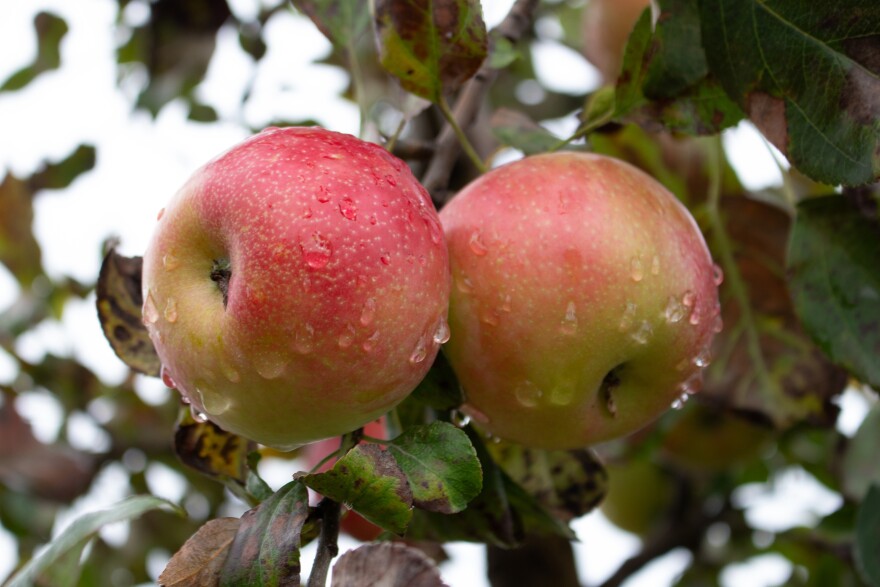It’s easy to get caught up in bad news. But a lot of things have gone well in Vermont in 2024, and we’re taking a moment to give thanks.
From sightings of rare plants and animals to moments of awe that brought humanity together, here are some of the stories we’re grateful to have covered this year.
Animal sightings
Vermont’s lush forests and wetlands, clear rivers and expansive lakes, rolling hills and rocky ridges make habitats for a variety of wildlife.
People might think first of our mammalian friends, like the moose that traverse the wetlands and woods — and whose population appears healthier, wildlife officials say, than in previous years.
And for the first time in decades, genetic evidence of the federally endangered shortnose sturgeon was confirmed in several areas of the Connecticut River. The species is over 70 million years old.
In a rare reptilian sighting, Vermont Fish and Wildlife personnel found a black racer snake in Southern Vermont — a first after 10 years.

If you need more animals to be thankful for, look to the skies, like the kids in Trish O’Kane’s Birding to Change the World class. Over Lake Champlain, tons of seabirds migrate south each fall, putting on a show and giving birders a glimpse at some unusual species. And in the state’s sugar bushes, syrup makers are adopting management practices that prioritize the dozens of bird species who use the maple stands for habitat.
Finally, in domestic animal news, a cat named Max was given an honorary doctorate degree — in “litter-ature” — from Vermont State University in Castleton. Congratulations, Dr. Max!
This land is our land
However you get your outdoor fix in Vermont, you likely rely on public lands. This year, Vermont added several beautiful areas to its bank of conserved lands.
At the start of the year, 5,000 acres of forest in the Green Mountains were permanently conserved.
This fall, the longest remaining stretch of the Long Trail with no permanent public access agreement was conserved through a permanent easement. The move protects public access to a 1.5-mile section of trail that runs over Middlebury College's Snowbowl ski area in perpetuity.
And, in the Northeast Kingdom, Wheeler Mountain — a popular hiking and historic rock climbing destination near Lake Willoughby — was also conserved for public access forever.
In Island Pond, a 15-acre private island became part of Brighton State Park. The island is home to a red pine forest and is a breeding habitat for bald eagles and loons.
And after years of searching for the right property, Monkton is getting a town forest. The 450-acre parcel had most recently been managed for timber and includes beaver wetlands and ponds, vernal pools and forest types that are uncommon across the state.
Things that made us cheer
On April 8, northern Vermont found itself in the path of a total solar eclipse that gave Vermonters and visitors from across the country a moment of awe.

Amid streaks of translucent clouds, the sun became a glowing ring in the sky, soliciting tears, shouts, proposals, dancing and all other forms of happiness and awe. People watched the celestial event from farms and canoes, from rooftops and mountaintops. At least one 104-year-old Vermonter watched a total eclipse pass over their home state for the second time in their life.
This summer, Vermonters tuned into the Olympics to support a few of our own. The Vermont athletes included the runner Elle St. Pierre and a young rower, Billy Bender. But Ilona Maher, a rugby sevens player who grew up in Burlington, stole the spotlight with her fun and relatable social media antics — and earned a bronze medal. Ilona’s time in the spotlight hasn’t ended with the Olympics. She was a finalist on the most recent season of Dancing with the Stars.
In June, people from Woodstock and beyond gathered to cheer for athletes of the aesthetic sort. A high heel race during Pride month had a crew of fashionably dressed folks click-clacking through the streets of one of Vermont’s most picturesque towns.
Take a moment for the plants (and fungi)
What makes the Green Mountain State green? Plants. And there’s been some scintillating plant news this year.
In the stands of ostrich ferns near an Addison County river, a tiny plant proliferated quietly, until it was spotted by a Fish and Wildlife official this spring and identified as false mermaid-weed. It was the first time this little plant had been seen in the state in 100 years.
Near the shoreline of Lake Champlain, three unassuming plants are direct remnants of the lake’s formation by glacial erosion and its past as a sea. Officials and volunteers are working to protect the plants and manage the areas where they thrive.
In the world of mycelium, Vermont got a state mushroom this year. A group of students helped push for the bear’s head tooth mushroom to become Vermont’s state mushroom. The bear’s head tooth, like its cousin lion’s mane, is edible and medicinal.
Making Vermont more accessible
We can all get behind efforts to increase access to great things.
Ahead of the eclipse in April, we covered a device that translates the light of the eclipse into sound, allowing people who are low-vision or blind to enjoy the celestial event. One Vermont user of the device, called LightSound, even tweaked the tones coming from his LightSound by adding reverb and layering.
At Burlington’s waterfront, officials from the city and the Vermont Association for the Blind and Visually Impaired unveiled a tactile map, meant to help people who are low-vision or blind navigate the popular area.

And in the mountains near Bolton, a new trail network called the Driving Range is the first in the state that is fully accessible for adaptive mountain bikes. That means people like Greg Durso of Burlington, who has a spinal cord injury and rides a prone-position bike, can speed down hills and make jumps without worrying about inaccessible obstacles like narrow bridges on the trails.
The art of it all
What’s cooler than good music, clothes and art? The people behind the craft.
Like these Indigenous students from Dartmouth College, who put on their own fashion show last month. The annual Indigenous Arts and Fashion Show was part of the school’s Indigenous Peoples’ Month celebrations, and highlighted students’ favorite Indigenous clothing and jewelry — some of which was handmade by parents or the students themselves.
Speaking of creative families: This Shelburne family is connected through music — now more than ever. Caribbean Rain, the state’s only multigenerational Jamaican musical group, is made up of the Dyke family. And after Mikey Dyke suffered a stroke in March, the family band is still turning to music.

And for any art history fans in the state, this story is straight out of a movie — but don’t worry, it has a good ending. When Dane Reichsmann was sent to Auschwitz in 1941, his possessions — including his art collection — disappeared. But his grandson, Andy Reichsman, had been trying to track it down from his home in Marlboro for decades.
Delicious offerings
It’s safe to say that food is on a lot of people’s minds this time of year — but Vermont has been hungry all year, and there are plenty of good food stories to serve up.

The first step in farm-to-table eating is “farm” — and communities across Vermont celebrated during the fall season with apple and potato harvests.
And this summer, Vermonters embarked on a “bread bus” expedition to learn all things grain. Just within the past few years have Vermont farmers been able to produce their own grain crops, due to changes in the weather. And Vermont bakeries are now sourcing local grain for the first time in two centuries.
And speaking of food for the soul: Harmony Edosomwan of Harmony’s Kitchen is here to help. She’s serving up soul food — “Food made with the soul. It's authentically Black, Black made. And it's more so known for a lot of its Southern origin foods like fried chicken, baked mac and cheese, collard greens — all that good stuff” — out of her Winooski kitchen. Edosomwan also participated in the Goldman Sachs One Million Black Women program this summer with a plan to strengthen her business.
Have questions, comments or tips? Send us a message.





